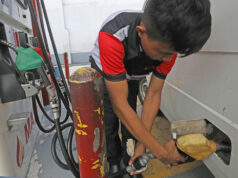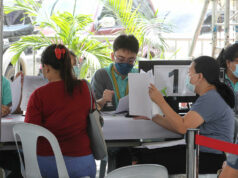Asia-Pacific faces imminent recession
A RECESSION across Asia-Pacific is “now guaranteed” amid an unprecedented disruption in the flow of people, trade and supply chains in large economies like China and the United States, with emerging countries in the region like the Philippines also likely to see spillover effects, according to S&P Global Ratings.
But Bangko Sentral ng Pilipinas (BSP) Governor Benjamin E. Diokno said the impact of the Luzon-wide enhanced community quarantine on the Philippine economy is still uncertain, but added that adverse effects could be minimized if the government’s efforts to arrest the spread of coronavirus disease 2019 (COVID-19) are successful.
In a report sent on Wednesday, S&P said a recession across Asia-Pacific is “now guaranteed due to a deep first-quarter shock in China and the shutdown of activities across G7 economies.”
“By recession, we mean at least two quarters of well below-trend growth sufficient to trigger rising unemployment. Asia-Pacific growth in aggregate will likely more than halve to less than 3%,” it said.
S&P noted the Philippine economy has exposure to final demand from the US and Europe of 2.6% and 4.7%, respectively, totaling 7.3% of the country’s gross domestic product (GDP).
Moreover, S&P said the virus spread will be an issue in Asia’s emerging markets where health care infrastructures remain weak.
“Restrictions are now being imposed in some of these countries — for example, the lockdown of Metro Manila in the Philippines — reflecting that risks have increased,” the report said.
“As household and business confidence in these economies erode, we will start to see domestic demand suffer,” it added.
S&P already downgraded its 2020 growth outlook for the Philippines to 5.8% from the 6.2% penciled in last December. If realized, this would be slower than the 5.9% GDP growth in 2019 and also below the 6.5-7.5% government target for the year.
The debt watcher said the loss of household and business confidence in Asia Pacific will lead to “severe and more persistent supply and demand shocks,” paired with higher unemployment rates.
It noted that policy responses from governments across the world, including the emergency rate cuts from the US Federal Reserve and the scaled-up asset purchases of the Bank of Japan could “cushion but not quickly reverse these shocks”.
“Local measures aiming to support vulnerable sectors and workers, such as a payroll tax cut in China, may help but their effect will wane the longer the crisis lasts,” S&P said.
IMPACT OF LOCKDOWN
BSP’s Mr. Diokno said the impact of the Luzon lockdown is yet to be assessed.
“What’s the impact of the Luzon-wide community isolation on the economy? I don’t know yet. But it will definitely have an impact,” Mr. Diokno said in a text message.
“If it (quarantine) succeeds, the adverse impact will be minimal and we can expect a V-shape recovery; if it fails, the adverse impact can be large and protracted, and the recovery can be an elongated U,” Mr. Diokno said in a text message.
The central bank chief said the lockdown, which is a temporary move to arrest the further spread of COVID-19, falls within both the first and second quarter of the year.
“It will straddle two quarters — two weeks out of 13 weeks in Q1 and another two weeks in Q2,” Mr. Diokno said of the lockdown that is scheduled to end on April 12.
Meanwhile, citing data from the Philippine Statistics Authority, the Economic Research Unit (ERU) of UnionBank of the Philippines, Inc. said the Luzon-wide lockdown will affect 73% of the total GDP of the country.
“Thus the economic impact on these particular regions will be significant. Both Q1 and Q2 GDP growth will significantly slow down,” UnionBank’s ERU said in a report on Tuesday, noting that they expect first-quarter GDP growth to settle below five percent.
“If the local virus containment efforts succeed by April 12th and the parallel global efforts also succeed, then, a slight recovery can be expected in Q3 and a more robust one in Q4,” the report added.
“A major part of the Philippine economy is the Service Sector at 49% composed of services-related sub-sectors directly affected by the COVID-19 health scare like tourism, transport, airlines, real estate, retail, and other services,” it said.
It said trade-related firms in the manufacturing sector will also be affected as China’s shutdown has had an impact on export and import companies.
With the enhanced community quarantine in Luzon, UnionBank’s ERU said they expect the Build, Build, Build program — seen as a key growth boost by the government — to be disrupted as firms have to limit their activities.
The report also said countries like Italy, China, Iran, Korea, Spain, Germany, France, the US, Switzerland, and the UK, which have recorded the highest number of COVID-19 patients, make up 50% of remittance flows to the Philippines.
“This is a significant portion of overall levels and future remittance inflows may be affected consequently for the coming months,” the report said.
Data from the BSP showed cash remittances in January, when the virus had yet to reach pandemic level, grew 6.6% year on year to $2.648 billion. Analysts have, however, warned the next months’ inflows could be strained due to the impact of the virus.
BSP’s Mr. Diokno has said the central bank is ready to use its policy tools to battle the impact of the outbreak on financial markets and the country’s growth prospects.
The Monetary Board will have its second policy-setting meeting for the year today (March 19). Mr. Diokno earlier said they might slash rates by more than 25 basis points following easing moves and stimulus from central banks in the US, Japan, New Zealand, South Korea, and Vietnam, among others.
The overnight reverse repurchase rate of the central bank is currently at 3.75%, while overnight lending and deposit rates are at 4.25% and 3.25%, respectively.
There were 202 confirmed COVID-19 cases in the country as of 4 p.m. Wednesday, with 17 deaths recorded. — L.W.T. Noble



